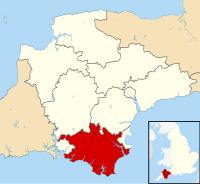Soar, Devon
| South Hams | ||
|---|---|---|

|
||
|
||
 South Hams shown within Devon |
||
| Coordinates (Totnes): 50°25′53″N 3°41′28″W / 50.43139°N 3.69111°WCoordinates: 50°25′53″N 3°41′28″W / 50.43139°N 3.69111°W | ||
| Sovereign state | United Kingdom | |
| Constituent country | England | |
| Region | South West England | |
| Non-metropolitan county | Devon | |
| Formed | 1 April 1974 | |
| Government | ||
| • Type | District council | |
| • HQ | Totnes | |
| • Sub-divisions | Civil parishes | |
| • UK Parliament |
South West Devon Totnes |
|
| • MPs (respectively) |
Gary Streeter Sarah Wollaston |
|
| • Political party | Conservative | |
| Area | ||
| • Total | 342.28 sq mi (886.51 km2) | |
| Area rank | Ranked 39th | |
| Population (mid-2015 est.) | ||
| • Total | 84,500 | |
| • Rank | Ranked 288th | |
| • Density | 250/sq mi (95/km2) | |
| • Ethnicity |
99.09% White
|
|
| ONS code | 18UG | |
| Website | http://www.southhams.gov.uk | |
South Hams is a local government district on the south coast of Devon, England. It is administered partly by South Hams District Council, which has its headquarters in the town of Totnes, and partly by Devon County Council in the nearby city of Exeter. The area also contains the towns of Dartmouth, Kingsbridge, Ivybridge, Salcombe — the largest of which is Ivybridge with a population of 11,851.
To the north it includes part of Dartmoor National Park, to the east borders Torbay, and to the west Plymouth. It contains some of the most unspoilt coastline on the south coast, including the promontories of Start Point, and Bolt Head. The entire coastline, along with the lower Avon and Dart valleys, form most of the South Devon Area of Outstanding Natural Beauty. The South Hams, along with nearby Broadsands in Paignton, is the last British refuge of the cirl bunting.
The South Hams were originally part of the Brythonic (Celtic) Kingdom of Dumnonia later reduced to the modern boundary at the River Tamar as Cornwall presumably during the tenth-century reign of Æthelstan. Post-Roman settlement on coastal promontory hillforts, such as Burgh Island, follows the established pattern of trading—of tin in particular—found across the western, so-called 'Celtic', Atlantic coastal regions. In the later Anglo-Saxon era, the South Hams was a feudal estate consisting of all of the land between the River Plym and River Dart and south of Dartmoor with the English Channel forming the southern boundary. There is some evidence that Cornish was spoken and understood in the area until the late Middle Ages.
...
Wikipedia

